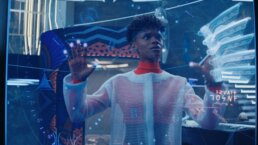A few years ago, my business partner and I made the important decision that we would no longer agree to do free pitches. It wasn’t an easy one, to be sure, but a necessary one. So after more then a decade of freely showing off the incredible work my design team is capable of (to just about anyone that invited us), I realized how damaging this really was on so many levels. Though I’ve read countless ‘business consultant’s’ advice on the matter, been on speaker-panels about it, and spoken about it at length, I never fully made the pledge to start saying “No” when the phone rang with someone on the other end asking for pitched ideas.
While I’ve always believed that “the idea” is at the core of what we do, it was only after several years of close study and first hand experience pitching world class creative for zero return, that clarity really took hold. After all, thinking up the winning idea that leads to a successful product for our clients is the single greatest achievement my team can have. The creative in me was always overly excited to impress a potential relationship, to see the look of astonishment in their eyes (a carryover from my youth as an amateur magician), and ultimately help them achieve their most ambitious business goals. However, the entrepreneurial side of me got tired of watching our brilliant ideas just given away—or worse—seeing winning ideas we offered up in good faith being taken and repackaged without our involvement. A great moral dilemma was formed.
Our ideas—the intangible-light-bulb-going-off-magical-moment-lighting-striking-brilliance that could result in tremendous fame and fortune to our clients—are the very foundation of our business. It is our raison d’être; the entire reason why we are hired. If those ideas are given away for free, then the market value is really set at zero. Furthermore, it devalues the work of everyone in our industry in the eyes of our shared network of customers. Certainly, we are all highly skilled and trained technicians, able to bring any idea to life across a multitude of platforms, but we are most definitely not a commodity. So while certain skill sets can be found universally across any successful agency’s talent pool, it’s always going to be that specific team’s groundbreaking ideas that set them apart from the rest of the pack. That’s what they are hired for; and that’s where a huge portion of the value lies for any creative services engagement.
It’s always challenging to resist the temptation of “showing off” how creative and smart we are at an initial meeting, and firing up a brainstorm marathon with a brand new potential client. However, in those moments, I have learned to resist. It’s way more important to listen closely, to take it all in, ask a lot of pointed questions, absorb as much information as possible, in order to create a proposal that will lead to the solution—but NOT to propose the actual solution.
And, once we are fully engaged—then, it’s time to play.
After being in business for so long, so many patterns repeatedly present themselves to me. Over the years, I’ve learned to become a master of pattern recognition. I can now quickly identify a potentially damaging opportunity that’s disguised as a “chance of a lifetime,” within the opening seconds of a conversation or the first words of an email inquiry. Pattern recognition and anticipation can make me seem psychic at times (to be discussed in a future blog), but has helped steer my company away from some potentially injurious situations. It has also lead to creating a series of internal “rules” to guide decision making when we are contacted about a potential project. As in stock trading, having a strict set of rules helps take the emotion out of the decision—and when you stick to the rules, you end up saving your hide. Too often, free pitches disguised as ‘opportunities’ touch on our most emotional and creative nerves, and the urge to say yes can be overwhelming. That’s where the rules take control, and prevail over feelings. I won’t disclose specific rules here, but I will offer a few clues to look for that should send up the caution flag for any creative team:
-any sign that indicates if you are being called to just fill in a ‘third slot’ in a triple bid situation being done for corporate policy reasons, though the clear advantage will go to a long standing relationship with an incumbent team.
-the sense that the agency is just “trolling” for ideas and looking for a free idea generation lab.
-the contact ultimately has no decision making authority, and was sent to go fishing for teams willing to pitch ideas to this subordinate group (who couldn’t hire you, even if they wanted to).
-the indirect indication that ideas aren’t necessary to win the job, but “would be really helpful.”
Often, the best ideas are the simplest. On occasion, the first one you think of in a matter of seconds, will be the winner. More often, its a much longer endurance test of brainstorming, sketching, writing and then starting all over again in a creative loop that ultimately leads to the breakthrough. Ideas can come in your sleep, in the shower, on the toilet, working out, eating a meal; indeed at times it may seem like they will appear just about anywhere except at your desk when you’re looking for it most intenseley. But almost always, the best ideas are the ones you see and immediately wish you thought of yourself. It’s those winning ideas—the ones that motivate consumers, impact culture, set trends, spark movements, and change the world—that can never be fully quantified. How can an exact dollar amount possibly be calculated? It certainly can’t be based on a time and materials model–after all the best ideas can come in 5 mins, or 5 hours, or even 5 months. The value of the idea is still enormous despite the amount of time it took to think it up.
So much has been written on the subject of ideas and pitching; I have at least two dozen books on my office bookshelf on the matter. Not a day goes by where I don’t see a tweet or a blurb on it—from Dan Cassaro’s letter to Showtime that blew up the internet this summer to the great video by DDB Asia’s called The Idea Catchers, it’s always a fiery topic of great discussion among my peers. The message is clear and well articulated, but not enough are listening. Our ideas are the most valuable thing we offer, and simply can’t be given away. Creative bake offs and free pitches never result in the quality of work we are sought out for, and only serve to lessen all of our collective worth. We will pitch our process, present our team, share reservoirs of relevant inspiration material, walk through countless case studies all day long to win a potential opportunity—but giving out million dollar ideas as freely as we hand out business cards just can’t happen anymore. Should creative teams be selected on the basis of free ideas they’re willing to give away? Or should it be for their collective expertise, body of past work, how closely they listen, and ‘get’ the client’s specific needs? Clearly, I’m a proponent of the latter, but if the former is the primary criteria, then the model is indeed broken.
The Idea Catchers
Jeremy Lasky
An entrepreneur and creative leader, Jeremy Lasky started his career at R/GA right after graduating from Carnegie Mellon University where he studied Graphic Design, Architecture and Business. For 5+ years he lead design efforts for feature films, global ad agencies and broadcast networks. In the Fall of 2001, Lasky co-founded Perception, a cutting edge motion graphics studio that lead the revolution in creating groundbreaking design and visual effects on the desktop. Now in it's 18th year, the studio has sharpened its focus to become global experts in designing futuristic UIs for both feature films and for the most powerful brands in technology. From Iron Man to IBM, from The Avengers to SpaceX, the studio has an extremely unique niche that truly bridges the gap between science fiction and science fact. Lasky leads new business strategies, shapes the company’s growth, while overseeing a full-time staff of 15.
Lasky has been a keynote speaker and presenter at: Promax 2016, Disney Art Summit, Disney Creative Loop Series, Science of Team Science Conference, Biogen Techology Innovation Symposium, TV of Tomorrow Conference, and Razorfish's Global Creative Summit. Lasky has lectured on design and guest speaker at OTIS, SCAD, Carnegie Mellon’s ETC and NYU ITP. He's also given presentations and workshops at some of the biggest tech giants in the world including Samsung, IBM, SpaceX, Intel, Microsoft, GE, Yahoo, Audi, Mercedes, Ford, Chrysler, Visa and Apple.
Lasky’s work has been featured in dozens of design and industry publications and he has garnered many of the most prestigious awards in the design world including AIGA, The Art Director’s Club, Broadcast Design Association/Promax, CLIO, International Andy Awards, Monitor Awards, New Media Invision Awards, One Show Awards, The Charleston International Film Festival Awards, Telly Awards, and The Type Directors Club.


